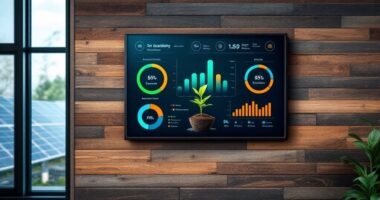Sustainable packaging materials offer Earth-friendly alternatives to petroleum-based plastics. Biodegradable options like PLA and PHA break down under specific conditions, while innovative plant-based solutions from mushrooms, bamboo, and seaweed decompose naturally like autumn leaves. Paper products boast high recycling rates despite water-intensive production. Reusable containers—though requiring more initial resources—significantly reduce lifetime environmental impact. Minimalist approaches cut waste by using only necessary materials. The packaging revolution has more solutions than most consumers realize.

While modern convenience has led to a packaging explosion that threatens our environment, a revolution in sustainable materials is quietly changing how products reach consumers. The packaging industry, once dominated by petroleum-based plastics designed to last centuries, is now embracing alternatives that tread more lightly on our planet.
As our landfills overflow with packaging past, innovative materials are reshaping tomorrow’s unboxing experience with the planet in mind.
Think of it as nature’s comeback tour, with starring roles for materials that eventually return to the soil rather than floating eternally in our oceans.
Biodegradable plastics represent one of the most promising alternatives. Made from renewable resources like corn starch and sugarcane, materials such as PLA and PHA can break down under industrial composting conditions.
They’re like the responsible party guests who actually clean up after themselves – though they do need the right conditions to do their disappearing act.
Paper and cardboard packaging continue their reign as the reliable workhorses of sustainable packaging. With global recycling rates exceeding 60%, these wood-pulp derivatives offer practical solutions for everything from shipping boxes to protective wraps. Corrugated cardboard is especially valuable as it can be recycled up to 7 times while maintaining its structural integrity.
However, their production remains remarkably thirsty – requiring substantial water resources that make them less than perfect environmental citizens.
Plant-based innovations are pushing boundaries even further. Packaging derived from bamboo, seaweed, and even mushrooms offers truly biodegradable alternatives with considerably reduced carbon footprints. Mushroom packaging made from agricultural waste and mycelium can form solid shapes in just days and fully decomposes when discarded.
These materials break down like autumn leaves rather than persisting like plastic monuments.
The recycled plastics market continues expanding, with materials like rPET and rHDPE giving plastic waste a second life. The shift toward these materials helps address the plastic pollution crisis devastating marine ecosystems worldwide.
It’s packaging reincarnation – though the quality can degrade with each cycle, limiting applications.
For the truly committed, reusable packaging systems offer the most substantial environmental benefits. Glass containers, metal tins, and fabric bags might require more resources initially, but their repeated use dramatically reduces lifetime impact – like choosing a ceramic mug over thousands of disposable coffee cups.
Ultimately, the most sustainable packaging might be the packaging that isn’t there at all.
Minimalist approaches focus on using precisely what’s needed – nothing more, nothing less – proving that sometimes, less truly is more.
Frequently Asked Questions
How Much More Expensive Are Sustainable Packaging Options?
Sustainable packaging typically costs 25-50% more than conventional options initially.
Paper-based alternatives are generally the most cost-effective eco-friendly choice, while biodegradable plastics run 20-30% higher than traditional plastics.
Recycled PET commanded a 30% premium over virgin PET in 2021.
These price differences stem from limited production scale, higher manufacturing costs, and R&D investments.
However, economies of scale are expected to gradually reduce this price gap over time.
Can Consumers Recycle All Types of Sustainable Packaging?
No, consumers cannot recycle all types of sustainable packaging.
While paper and cardboard are widely accepted, bioplastics often require specialized facilities unavailable in many areas.
Glass and metal recycle well but are less common in sustainable packaging.
Composite materials present particular challenges.
With only 9% of plastic waste recycled globally, infrastructure limitations and consumer confusion compound the problem.
Clear labeling and education remain essential for improving recycling rates of sustainable packaging materials.
Which Industries Are Leading in Sustainable Packaging Adoption?
The food and beverage industry currently leads sustainable packaging adoption, with 59% of consumers rating it positively.
Pharmaceutical packaging follows closely, valued at $87.24 billion with impressive 14.2% projected CAGR through 2030.
Personal care companies are gaining momentum—42% of consumers approve of their efforts.
E-commerce is rapidly evolving its practices in response to online shopping growth, with innovations like Amazon’s “Frustration-Free Packaging” and paper-based alternatives replacing traditional materials.
How Long Do Biodegradable Packaging Materials Take to Decompose?
Biodegradable packaging materials decompose at varying rates.
Home compostable items break down in 6-12 months, while industrial compostable materials take around 180 days.
Cornstarch packaging decomposes in 2-4 months, and mushroom packaging in 30-90 days under proper conditions.
Paper biodegrades in 2-6 weeks, while hemp packaging takes 6-9 months.
Decomposition speed depends on environmental factors like temperature, humidity, oxygen availability, and the presence of microorganisms that facilitate the breakdown process.
What Government Regulations Exist for Sustainable Packaging?
Government regulations for sustainable packaging are expanding globally.
Five U.S. states have passed Extended Producer Responsibility laws requiring manufacturers to fund recycling systems. Many regions mandate recycled content in packaging—California requires 50% in plastic beverage bottles by 2030.
The EU’s Packaging and Packaging Waste Regulation aims to increase recyclability across member states.
Meanwhile, single-use plastic bans continue spreading, and recyclability standards are becoming stricter, with California requiring all packaging to be recyclable or compostable by 2032.









